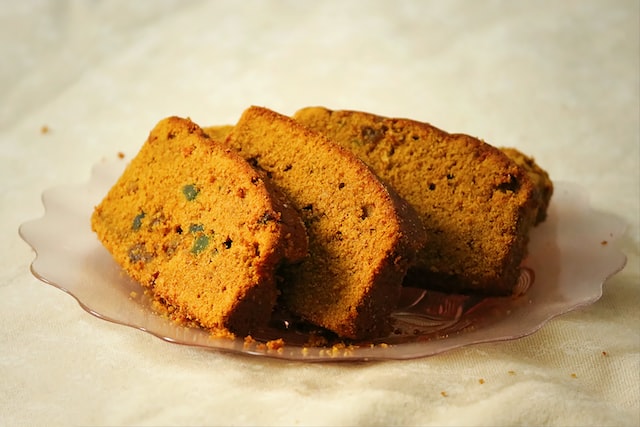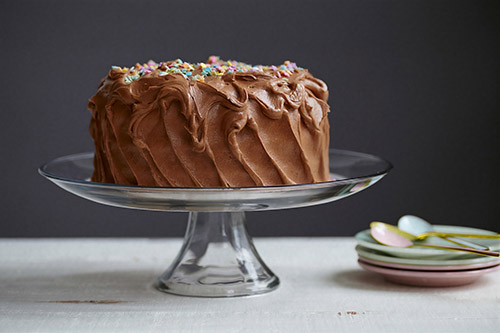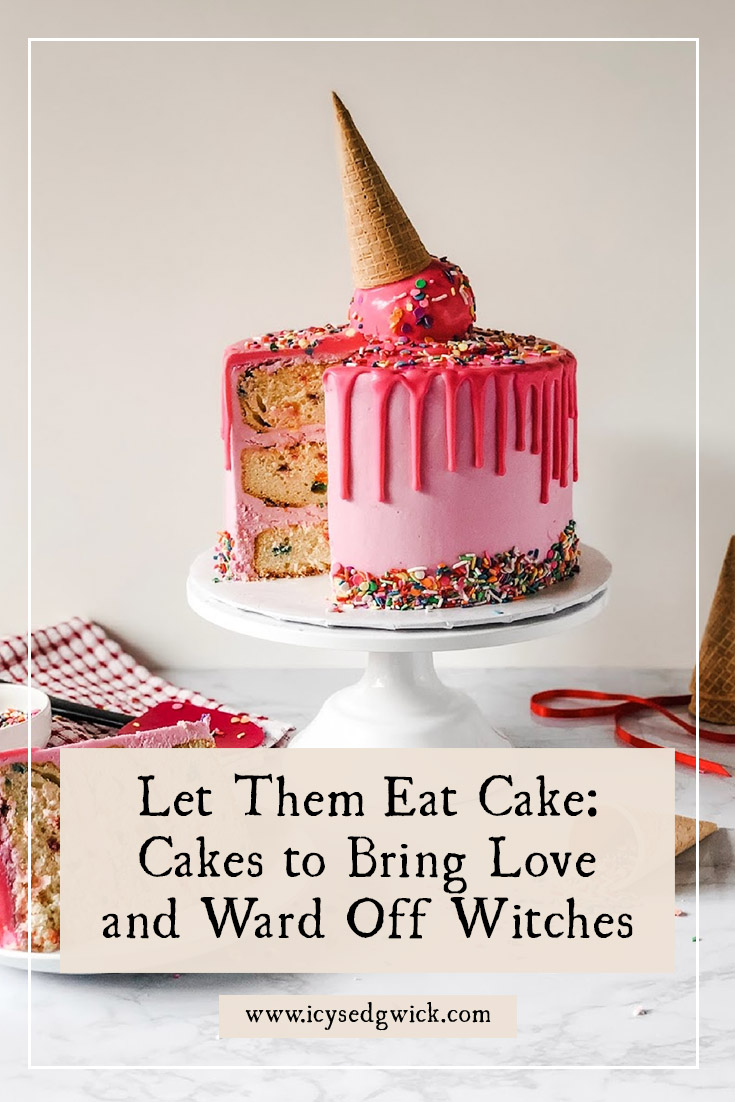According to the Venerable Bede, what we call February was called Sol-Monath by the ancient Britons. This translates to ‘Month of Cakes’ and the people gave cakes to the gods as offerings (Gazur 2022). I don’t know about you, but that’s a practice I could get behind.
It’s worth bearing in mind that what we think of as ‘cake’ is not what people of earlier centuries had in mind. Often, early ‘cake’ was more like bread. The type of cake we eat now first emerges in its original form in the mid-17th century.
Yet that doesn’t stop cake from accruing a whole range of folklore, helping people to ward off witches, find love, and celebrate important occasions.
Speaking of which, if you’d like to learn more about the wedding cake, then head on over to my wedding folklore blog post! I’ve also talked about soul cakes before as a Halloween custom.
But without any further ado, let’s look at cakes that can predict the future, bring good luck, and bring some sweetness to an occasion!
Why do we eat simnel cake at Easter?
Simnel cake is a common sight at Easter. This light fruit cake is topped with marzipan and eleven marzipan balls, often considered to represent the twelve disciples minus Judas. It usually has another layer of marzipan in the middle.
The word ‘simnel’ is a tricky one to trace, though it originally comes from simila, Latin for a type of finely ground flour. By the 15th and 16th centuries, simnel referred to cakes and bread made using the flour (Lee 2019).
But by the early 17th century, simnel cake had begun to take over from simnel flour or bread. It didn’t include milk or butter but contained plenty of dried fruit. People also boiled their cakes before baking them, and simnel cake was more like a pudding.

In the 17th century, simnel cakes became linked with Mothering Sunday. Mothering Sunday fell during Lent and marked the day when people returned to the church where they’d been baptised – i.e. their mother church. This only became Mother’s Day much later. But since cream and butter were off the menu during Lent, simnel cake became popular since it contained no dairy and all its ingredients were dried (Lee 2019).
By the end of the 19th century, simnel cake expanded to become an Easter treat too. You won’t be surprised to learn it was adopted at the same time as Easter bonnets and sending Easter postcards. It’s actually pretty gross how the Victorians ‘branded’ their celebrations.
Where it was once most common in the north and west of England, simnel cake gradually spread to the rest of the country. The Shrewsbury version caught on the fastest, with a thick marzipan coating (Lee 2019). The eleven marzipan disciples are a 20th-century addition. They’re usually toasted with a blowtorch or grill, though I’m not sure of the symbolism of that!
Protective Cakes
If you wanted to ward off witches, you could do so using witch cakes. This 19th-century custom saw people baking specific round cakes that had six ‘points’ and a hole in the middle. They baked the dough until it was hard, drying it in the oven. Then they hung these strange, spiky baked goods behind the door to keep out witches. You had to make them between 1 and 6 April, and you’d replace them every year, burning the previous year’s witch cake (Dunne 2017).
Meanwhile, a practice recorded in Belford, Northumberland in the 1890s was that of the ‘burial cake’. According to records, they were more like yellow bread, but flavoured with sweeteners and spices. The cake would stand beside the corpse’s head, and you would put a piece in your mouth if you look at the body. This would prevent evil from befalling you (Opie 2005: 49).
Groaning Cakes
There was a tradition in England’s northern counties to give new mothers slices of fruitcake or gingerbread. Apparently, Cheshire cheese was a favourite choice too. Female neighbours would come in and share the cake to celebrate the birth (Opie 2005: 157). William Henderson describes the version in Yorkshire as being called “pepper-cake, and somewhat resembles thick gingerbread” (1879: 11).
The cake also offered divinatory opportunities. The new father or the doctor would cut the cake (or cheese) into chunks, which were tossed in the midwife’s apron. Then the new father handed these to unmarried girls in the room, and they’d put them under their pillow to dream of the man they would marry.

In some places, the new parents would keep a slice of the groaning cake and take it with them when they took the baby to their christening. They’d give the slice to the first person they met of the opposite sex to the baby.
The term ‘groaning cake’ had different meanings in Cambridgeshire, where it referred to a product intended to kill pain. It included crushed hemp seeds and gin, and the midwives gave it to women during labour (Opie 2005: 157).
The Baddeley Cake
Robert Baddeley was a chef turned actor, who trod the boards at Theatre Royal Drury Lane in Covent Garden. When he died in 1794, he also left £100 to provide wine and a Twelfth Night cake to the company at the theatre every year. Twelfth Night cakes were popular to mark the end of the Twelve Days of Christmas, although Christmas cakes replaced them in popularity.
People would add something to the cake, such as a bean or pea. Whoever found it in their slice would be ‘king’ for the day, or Lord of Misrule. The King Cake in New Orleans is a similar concept, with a small plastic baby hidden inside. If you find the baby, you have to bring the next cake or have a party. It always appears on January 6 at the start of Carnival. NewOrleans.com describes it as a mixture of coffee cake and cinnamon roll (n.d.).

But back to the Baddeley Cake. The tradition began in 1795 and the cast of the current production would gather in the Grand Saloon to be served cake by attendants wearing 18th-century clothing (Simpson 2003: 14).
More recently, the cakes have moved away from more traditional Twelfth Night cakes, and have been themed according to the production. I could find a record of it still taking place up until 2016, so I emailed LW Theatres, who run the theatre, to ask if it happened in 2023. They very helpfully responded within 15 minutes and it turns out yes, it went ahead! The cake was Frozen themed, since it’s the current production.
“Dumb Cake”
It wouldn’t be a Fabulous Folklore article without love divination, and dumb cake is an incredibly specialised one. In essence, it involves making a specific cake in absolute silence. Naturally, to modern ears, ‘dumb’ is considered an ableist term, but we can also call it a ‘silent cake’.
The recipe, and method, vary, but certain elements remain the same, and have done since it was first recorded in the 1680s (Simpson 2003: 100). Most traditions involve several people making the cake together. It nearly always includes a lot of salt, the participants have to mark initials onto portions, and they often put the cake under a pillow.
Earlier versions included soot and urine, which thankfully disappear in later recipes. They were most often made at midsummer, Halloween, St Agnes’ Eve and Christmas Eve. The tradition seems to have largely died out at the end of the 19th century.

William Henderson describes the variation practised in Durham and Yorkshire. It occurred on St Agnes’ Eve, and involved two young women. They spent the entire day in silence, not eating or drinking, and at night, they made their cake. Its ingredients included equal proportions of flour, salt and water. The girls even divided the tasks equally. Then they divided the cake in half, and each girl walked backwards upstairs with her half. Then she’d eat it and jump into bed. If she’d done it right, and kept her thoughts focused on a husband, she would see her future husband in her dreams (1879: 91).
He also notes a variation in which the girls made the cakes in thimbles, so they were easier to eat. When they got into bed, they laid out their stockings in a cross, and put their shoes in the ‘coming and going’ position – I covered both of these processes in the footwear article.
“Let them eat cake!”
I’m sure we all have a witty quip or similar that we’d love to have associated with us. In all likelihood, people will be more likely to remember the daft things we say. Marie-Antoinette is perhaps no different, often remembered for her phrase during the French Revolution.
If you believe the story, someone told the queen the peasants were starving and had no bread. Marie-Antoinette apparently said they could eat cake instead, and given cake’s expense compared to bread, many have assumed this shows her total lack of grasp on the reality of her subjects.
Except John Cunningham thinks she didn’t actually say it. The French phrase she’s quoted as saying was “Qu’ils mangent de la brioche”. So she actually told them to eat brioche, not cake – and while it was still more expensive than bread, it changes the type of cake that we imagine (2016).

There are also versions of the tale from different parts of the world. A noblewoman in 16th century Germany wondered the same, as an example. The story seems to be a way for people to underline how little their rulers understand the lived experience of their people. Sadly, we realise the same is true of our wealthy politicians now, except they’ve adopted the refrain “We’re all in this together”.
No one knows specifically why the quote was attributed to Marie-Antoinette. The earliest known source attributing the quote to the queen appeared in 1843, and the writer Jean-Baptiste Alphonse Karr claimed he’d found it in a book from 1760 – which would obviously mean it was false (Cunningham 2016). Either way, the quote stuck, and Marie-Antoinette will forever be remembered as the queen who told starving peasants to eat cake.
Cake-Related Superstitions
I thought we’d end with some cake superstitions.
When you move house, your first visitor should bring cake so life in the house will be sweet (Carroll 1998: 290).
Bake cakes before noon – the sun rising will help your cakes rise (Webster 2012: 46).
Don’t throw the eggshells out until the cake is baked (Webster 2012: 46).
If someone puts a slice of cake on your plate and it falls over, say ‘bread and butter’ to ward off bad luck (Webster 2012: 46).
What do you make of this cakey lore? And what’s your favourite type of cake?
References
Carroll, William (1998), Superstitions: 10,000 You Really Need, San Marcos, CA: Coda Publications.
Cunningham, John (2016), “Did Marie-Antoinette Really Say “Let Them Eat Cake”?”, Encyclopedia Britannica, https://www.britannica.com/story/did-marie-antoinette-really-say-let-them-eat-cake.
Dunne, Jennifer (2017), ‘The Clarke Charm Collection: Of Witch Bottles, Witch Cakes and Hag Stones’, Folklore Thursday, https://folklorethursday.com/material-culture/superstitious-charmed-life-william-james-clarke/.
Gazur, Ben (2022), ‘The weird folklore of British cakes’, Wellcome Collection, https://wellcomecollection.org/articles/Yfe1NxAAACUADUKQ.
Henderson, William (1879), Notes on the folk-lore of the northern counties of England and the borders, London: W. Satchell, Peyton and Co.
Lee, Alexander (2019), ‘Have Your Simnel Cake and Eat It’, History Today, https://www.historytoday.com/archive/historians-cookbook/have-your-simnel-cake-and-eat-it.
NewOrleans.com (n.d.)., ‘Taste the Tradition of a New Orleans King Cake’, New Orleans, https://www.neworleans.com/events/holidays-seasonal/mardi-gras/history-and-traditions/king-cakes/.
Opie, Iona and Moira Tatem (2005), Oxford Dictionary of Superstitions, Oxford: Oxford University Press (affiliate link).
Simpson, Jacqueline and Steve Roud (2003), A Dictionary of English Folklore, Oxford: Oxford University Press (affiliate link).
Webster, Richard (2008), The Encyclopedia of Superstitions, Woodbury, MN: Llewellyn (affiliate link).
Nutty about folklore and want more?
Add your email below and get these posts in your inbox every week.
You'll also get my 5-step guide to protecting your home using folklore!








Thank you Icy. I always enjoy your episodes and am continually impressed by your research and broad spectrum of knowledge. I especially appreciate the source lists!